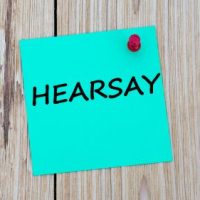What do the First Three “Spontaneity” Exceptions to the Rule Against Hearsay Look Like in Real Life?

The first three exceptions to Indiana Rule of Evidence 803, or the Rule Against Hearsay, are based on spontaneity or spontaneous utterances. The reasoning for allowing these kinds of statements to be admitted is because they are based in spontaneity, there was not likely enough time for the party uttering the statement to be able to think about uttering false information. Essentially, there wasn’t enough time to lie.
These three exceptions include: 1) present sense impression; 2) excited utterance; and 3) statements of then-existing mental or physical condition. But what do these kinds of statements actually look like in practice? There are many different examples of each of these exceptions, and our Indianapolis criminal defense lawyers can tell you more.
Examples of the Present Sense Impression Exception
For the first exception, the present sense impression, the timing of the declarant’s statement is what is most important, and whether the statement was made at the time the event was taking place (or just thereafter). An example of a statement that might be entered as evidence under this exception could be: A person is on a Zoom work video that is being recorded, and that person is looking out their window when they see a white van speeding down the street. The person becomes distracted from the work call and quickly says to colleagues, “sorry, I got distracted by this white van speeding down my street!” The video of that call could potentially be considered an exception as a “present-sense impression.”
Examples of the Excited Utterance Exception
The second exception, the excited utterance, typically refers to a statement or phrase made in relation to an event or a condition that startled the speaker. The key to this exception is that the speaker was still under the condition of being startled or surprised when they made the statement. In other words, the speaker was under the excitement or stress of the moment when they made the statement.
The most common type of excited utterance, which can be admitted in a case as an exception to the Rule Against Hearsay, is a statement made by a witness or victim of a criminal act to the police or a 911 operator. For example, a person might have been the victim of a violent crime and called 911 on their phone. They are likely still shaking from the event, and are not thinking clearly as they speak in fragmentary phrases, noting information such as: “She had a gun and held it up to my face!” Or, a person might have just witnessed a crime and might call 911, startled, making a statement such as: “He pulled a gun out of his bag and shot at her!”
Examples of the Then-Existing Mental or Physical Condition Exception
The third spontaneity-based exception to the Rule Against Hearsay concerns a person’s then-existing state of mind or physical condition. This exception does not involve a person’s belief or opinion about what happened or what they witnessed. Rather, it is about how they feel in the present — mentally or physically. For example, a person might call 911 and say, “I am terrified!” Or, a person might say to a responding EMT or law enforcement official, “I am in excruciating physical pain right now — my leg hurts so much.”
Contact a Criminal Defense Attorney in Indianapolis Today for Assistance
If you have any questions or concerns about hearsay in relation to criminal charges you are facing, you should reach out to one of the experienced Indianapolis criminal defense lawyers at Rigney Law LLC. We can answer your questions and can get started on a defense strategy for your case.
Source:
rules.incourts.gov/Content/evidence/default.htm
